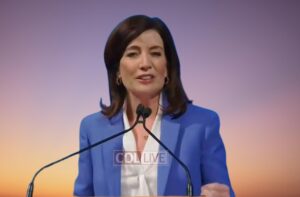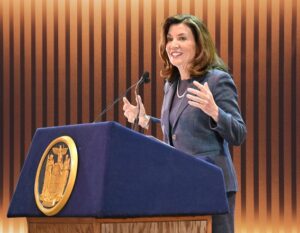Voter Turnout: Low voter turnout in New York City has been a persistent issue that hampers the democratic process and hinders the quality of governance. The local primary elections held in 2023 clearly demonstrated the disinterest of the average New Yorker in participating in the electoral process. Despite the city’s population of approximately 2.8 million eligible voters, only 182,277 ballots were cast by 6 p.m. on Election Day, resulting in a citywide turnout of a mere 6.5 percent.
Consequences of Low Turnout
The consistently low turnout in New York elections has alarming implications. When just a handful of voters have the power to choose the candidates who will represent the entire population, the democratic ideals of representation and accountability become diluted. In the recent judicial primary for civil court judges in Manhattan, for example, only 5,688 Democratic voters cast their ballots. This pattern repeats across the city, with winners of primary races being determined by a fraction of the population they are supposed to serve.
Impact on Policy Making
The repercussions of low voter turnout extend beyond the election process. Elected officials often fail to address the urgent needs of the majority of their constituents because they are not held accountable due to low voter participation. For instance, State lawmakers and Governor Kathy Hochul have failed to produce any significant legislation on the pressing issue of housing, despite it being the most urgent concern in New York. The usual assumption in Albany is that voters will not express anger or hold them accountable for their inaction.

Also Read : Hotel Workers Strike: In Southern California for Fair Wages and Benefits
Encouragement of Bad Behavior
The limited competition resulting from low voter turnout also leads to the encouragement of bad behavior among politicians. Incumbents feel secure in their positions and may engage in disrespectful or dismissive behavior towards their constituents. Recently, Mayor Eric Adams berated a distraught constituent who questioned him about the city’s Rent Guidelines Board’s decision to raise rents in regulated apartments. Such behavior undermines the trust and respect required for a healthy democracy.
Increasing Turnout for Better Government
To achieve better, more responsive government in New York, it is crucial to increase voter turnout in primary elections. This requires significant changes to the state’s election system. One promising bill that has passed both legislative chambers aims to shift local elections to even-numbered years, aligning them with federal races for president and Congress. By doing so, turnout is likely to increase as more people participate in local democracy. However, some incumbents oppose this shift, as they benefit from the status quo.
Overcoming Opposition
Governor Kathy Hochul should disregard the opposition, which primarily comes from suburban voices, and sign the bill into law. Shifting state and local elections to even-numbered years would alleviate election fatigue in New York City. In recent years, New Yorkers have been eligible to vote in multiple elections annually, including presidential elections, mayoral elections, congressional midterms, and various local races. The complexity and frequency of elections contribute to low public awareness and engagement.
Making Voting Easier
In addition to changing the election system, making voting more accessible is essential to boost
turnout. Adopting mail voting, for example, would simplify the process and likely increase participation. A bill that has passed the Legislature and awaits Governor Hochul’s signature proposes implementing mail voting in New York. However, unlike states such as Washington and Colorado where registered voters automatically receive mail ballots, New York voters would still need to request one.

Motivating Participation
Another strategy to increase voter turnout is to recruit more compelling candidates who resonate with New Yorkers. The June 27 primary saw higher turnouts in certain districts, such as Harlem, where Yusef Salaam, wrongfully convicted in the Central Park jogger case as a teenager, won a crowded Democratic City Council primary. His ability to captivate voters and actively campaign illustrates the potential of engaging candidates in motivating voter participation.
The Recipe for Better Government
New York’s current method of electing local and state candidates relies on narrow slices of the electorate, leading to flawed representation and governance. To improve the quality of government in one of the most populous and economically significant states in the nation, higher voter turnout is imperative. By addressing the challenges of low participation, implementing changes to the election system, and fostering an environment that motivates voters, New York can take steps toward a better future.
Conclusion Of Voter Turnout
Achieving better government in New York requires a collective effort to increase voter turnout. By recognizing the impact of low participation on the democratic process and the quality of governance, steps can be taken to address the root causes of disengagement. Reforms to the election system, making voting more accessible, and inspiring participation through compelling candidates are crucial components of a path toward better government. With higher voter turnout, New York can ensure a more representative and responsive political landscape that serves the needs and aspirations of its diverse population.
Our Reader’s Queries
What is the meaning of voter turnout?
In political science, voter turnout refers to the rate at which people participate in an election by casting their ballot.
What was the turnout of the 2018 election?
In 2018, over 122 million people, or 50.3% of eligible voters, cast their votes, marking a significant increase from the 36.0% turnout in 2014. The 2018 mid-term elections saw the highest participation rate since 1914.
What is the voter turnout in India?
Approximately 912 million individuals were qualified to cast their votes, with a voter turnout of over 67 percent the highest in history. Additionally, this election saw the largest-ever involvement of female voters.
What is the definition of voter apathy?
Voter apathy reflects a disinterest among voters in representative democracy elections. It is often blamed for low turnout in places where voting is optional and the compulsory “donkey vote”.

